| J-10 Vigorous Dragon | |
|---|---|
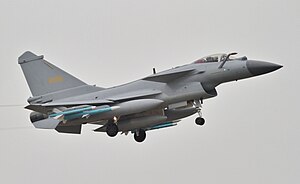 A J-10B carrying PL-8 and PL-12 air-to-air missiles A J-10B carrying PL-8 and PL-12 air-to-air missiles | |
| General information | |
| Type | Multirole combat aircraft |
| National origin | China |
| Manufacturer | Chengdu Aircraft Industry Group |
| Designer | Chengdu Aircraft Design Institute |
| Status | In service |
| Primary users | People's Liberation Army Air Force Pakistan Air Force |
| Number built | 600+ as of 2024 |
| History | |
| Manufactured | 2002 – present |
| Introduction date | 2004 |
| First flight | 23 March 1998 |
The Chengdu J-10 Vigorous Dragon (Chinese: 歼-10 猛龙; pinyin: Jiān-10 Měnglóng; NATO reporting name: Firebird), is a medium-weight, single-engine, multirole combat aircraft using a delta wing and canard design. It is produced by the Chengdu Aircraft Corporation (CAC) for the People's Liberation Army Air Force (PLAAF), Pakistan Air Force (PAF) and People's Liberation Army Naval Air Force (PLANAF). The J-10 is mainly designed for air-to-air combat, but can also perform strike missions.
Development
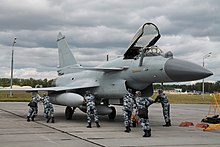
In 1981, PLAAF Commander Zhang Tingfa submitted a proposal to Deng Xiaoping for the development of a third-generation fighter for CN¥ 500 million; it was accepted later that year by the Central Military Commission (CMC). It was the first Chinese aircraft program to incorporate modern development and acquisition processes. In one departure from the past, the supplier was now responsible directly to the customer; this allowed the PLAAF to communicate its requirements and ensure they were met; previously suppliers were responsible to their managing agency, which could produce products that failed to meet end user requirements. Another difference was the selection of a design through competition, rather than allocating a project to an institute and using whatever design that institute created.
Design proposals were made by the three major aircraft design institutes. Shenyang's proposal was based on its cancelled J-13 with a F-16-like strake-wing. Hongdu's proposal was MiG-23/Su-24-like with variable-sweep wing. Chengdu Aircraft Design Institute's (CADI) proposal was a Saab 37 Viggen-like design based on its cancelled J-9. CADI's proposal was selected in February 1984. The following month, CADI and Chengdu Fighter Factory were formally directed to develop and manufacture the aircraft, respectively. Song Wencong (宋文骢) became chief designer.
The engine was selected during the design proposal stage. Candidates were an improved Woshan WS-6, the WP-15, or a new engine. The new engine, ultimately the Shenyang WS-10, was chosen in 1983.
The State Council and the CMC approved the program in 1986, code-naming it "No. 10 Project". Interest waned in the following years which constrained funding and prolonged development. The Gulf War renewed interest and brought adequate resourcing. Unlike earlier programs, the J-10 avoided crippling requirement creep.
Technical development was slow and difficult. The J-10 represented a higher level of complexity than earlier generations of Chinese aircraft. About 60% of the aircraft required new technology and parts, instead of - according to Chengdu - the usual 30% for new aircraft; the high proportion reflected both requirements and limited domestic capability. Development and modernization of China's aviation industry occurred alongside the J-10; the program was an early Chinese user of digital design, modelling, and testing including computer-aided design (CAD) and computational fluid dynamics. The J-10 was the first Chinese aircraft to make major use of CAD for its structural design, allowing the detailed design to be completed in 1994. The hydraulics system was tested with physical models because of limited digital modelling capabilities.
The first J-10 was assembled in June 1997. Lei Qiang flew the first flight on 23 March 1998; Lei was chosen for his experience with modern, foreign, third-generation aircraft. PLA training units received the J-10 ahead of schedule starting in 2003. Weapons tests occurred in the fall of that year. The design was finalized in 2004. Rumors of crashes during flight testing were actually mishaps related to the AL-31 engine.
The J-10 became operational in 2006. It was officially unveiled by the Chinese government in January 2007, when photographs were published by Xinhua News Agency.
The Siberian Aeronautical Research Institute (SibNIA) from Russia was involved in the program by 2006. According to SibNIA, it was only observing and instructing as "scientific guides".
According to the images posted by China National Radio of a PLAAF live-firing exercise at an unspecified location in May 2021, J-10C Vigorous Dragons were equipped with distinctive exhaust nozzles of the WS-10B Taihang turbofan engine. This marks the first time the WS-10 has been officially seen on an operational J-10.
Disputed origins
In 1988 Israel's defense minister denied a report by The Sunday Times that Israel and China had agreed to develop a fighter derived from the IAI Lavi, a project based on the F-16. In 2006, Russia's SibNIA engineers believed that the J-10 was "more or less a version" of the Lavi, incorporating "a melting pot of foreign technology and acquired design methods... but there are a number of other pieces of other aircraft or technologies that are part of the configuration that they have acquired from different sources." In 2008, Janes claimed that the J-10 benefited from technical information from the Israeli project, citing senior Russian engineers who said they had heard this from Chinese colleagues.
The Chinese assert J-10's features claimed to be from the Lavi are from the manufacturer's own previous aircraft design, for example attributing the J-10's Lavi-like double canard configuration to Chengdu's work on the cancelled J-9 of the 1960s and 1970s; this view is supported by Song Wencong, who worked on the J-9 and became the J-10's chief designer, and PLAAF Major General Zhang Weigang.
Design
| This section needs additional citations for verification. Please help improve this article by adding citations to reliable sources in this section. Unsourced material may be challenged and removed. (March 2010) (Learn how and when to remove this message) |
The J-10 was designed and developed by the Chengdu Aircraft Design Institute (CADI), a subsidiary of Chengdu Aircraft Corporation.
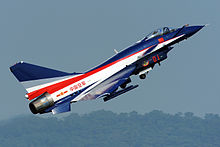
Avionics
The cockpit has three liquid crystal (LCD) multi-function displays (MFD) and a Chinese developed holographic head-up display (HUD). These are compatible with a Chinese helmet mounted sight (HMS); the Chinese consider the HMS of the imported Sukhoi Su-27 to be worse.
Radar
The early J-10s were initially equipped with the Type 1473 pulse-Doppler radar (PD) developed by the CETC 14th Institute; the Type 1473 has been called China's first "successful" or "practical" PD radar.
The J-10B is equipped with an active electronically scanned array (AESA) or passive electronically scanned array (PESA) radar. According to Chinese accounts, PESA was never used due to unsatisfactory performance; AVIC 607 Institute and CETC 14th Institute developed a PESA radar that could track multiple targets simultaneously but had shorter range than the PD radar. PESA and AESA development delayed the J-10B. CETC 14th Institute helped to develop the J-10B's AESA radar.
Propulsion

The J-10 is powered by a single turbofan. The J-10A entered production with the Russian Salyut AL-31FN. The initial version generated a maximum static thrust of 12,500 kgf (123 kN; 28,000 lbf). In December 2013, Salyut reported it was testing an upgraded AL-31FN Series 3 for China with 250 hours more life and 1000 kg/f more thrust; the Series 3 would be equipped on the improved J-10B. Compared to the original Lyulka-Saturn AL-31F, the AL-31FN was fitted to the J-10 by rotating the gearbox and accessory pack to the underside.
The J-10s intended engine is the Chinese Shenyang WS-10. The WS-10 suffered development difficulties and production of the aircraft went ahead with the Salyut AL-31FN as a substitute. A pre-production J-10C flew with a WS-10 at the 2018 China International Aviation & Aerospace Exhibition; the engine nozzle was modified for stealth and thrust vectoring (TVC). In March 2020, a video from Chinese state media showed a J-10C in PLAAF livery equipped with the WS-10B; WS-10B-powered aircraft were in service by November 2021.
Weaponry and external loads
The aircraft's internal armament consists of a Gryazev-Shipunov GSh-23 twin-barrel cannon, located underneath the port side of the intake. Other weaponry and equipment is mounted externally on 11 hardpoints, to which 5,600 kg (12,300 lb) of either missiles and bombs, drop-tanks containing fuel, or other equipment such as avionics pods can be attached.
Air-to-air missiles deployed may include short-range air-to-air missiles such as the PL-8 and PL-10 (on J-10C), medium-range radar-guided air-to-air missiles such as the PL-12 and PL-15 (on J-10C), unguided and precision guided munitions such as laser-guided bombs, air-to-surface missile such as KD-88, anti-ship missiles such as the YJ-91A, and anti-radiation missiles such as the YJ-91.
Operational history
China
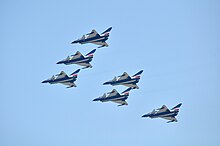
The first aircraft were delivered to the 13th Test Regiment on 23 February 2003. The aircraft was declared 'operational' in December of the same year, after 18 years in development.
The J-10C entered combat service in April 2018.
The J-10C has been reported to have consistently prevailed in simulated combat engagements against Su-35 fighters acquired from Russia, with the fighter's reduced radar visibility allowing it to detect and fire on its target first. The fighter's lower radar signature and significantly more advanced sensors and weaponry for both visual and beyond-visual range engagements were cited by experts as leading advantages the aircraft retained. The J-10C gained victories against both the Su-35 and the J-16 in exercises for three consecutive years from 2019-2021.
Pakistan
Negotiations for acquisitions for J-10A were started in 2006 when offered by China, but negotiations persisted into 2012 with the offer of the J-10B.
In September 2020, it was reported that Pakistan was interested in the J-10C. In December 2021, Pakistan announced the purchase of 25 J-10CEs, with an option for 11 more; they were expected to enter service in March 2022. On 4 March 2022, the first batch of 6 J-10CEs for the Pakistan Air Force (PAF) landed at PAF Base Minhas (Kamra) after a ferry flight from Chengdu, China. They were officially inducted into the PAF's No. 15 Squadron Cobras based at PAF Base Minhas on 11 March 2022.
On 18 January 2024, Pakistan launched a series of air and artillery strikes inside Iran, targeting Baloch separatist groups, multiple JF-17C and Wing Loong II drones escorted by J-10CE launched attacks against BLA and BLF militant groups with GIDS B-REK Glidebombs. 9 terrorists were killed in the attack.
Variants
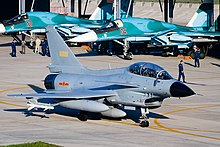

- J-10A: Single seat variant. The export designation is F-10A or FC-20.
- J-10AH: Naval version of J-10A.
- J-10AY: Aerobatics variant of J-10A.
- J-10S: Tandem-seated trainer variant of J-10A.
- J-10SH: Naval version of J-10S.
- J-10B: An upgraded J-10, initially identified as "Super-10". It features a lighter and stealthier diverterless supersonic inlet, a longer nose radome possibly housing an active electronically scanned array radar, an electro-optic targeting sensor (IRST, and laser rangefinder,) and a new electronic warning or countermeasures pod atop the vertical stabiliser. The aircraft is powered by the AL-31FN M1; one unit was flown with a WS-10A in July 2011 but that engine was not selected for the initial production batch. The aircraft's first flight occurred no later than December 2008.
- J-10B TVC Demonstrator: A prototype fighter based on J-10B that is equipped with WS-10B thrust-vectoring control engine. The fighter has supermaneuverability, capable of performing the Cobra maneuver.
- J-10C: An upgraded version of J-10B, it is equipped with an indigenous AESA fire-control radar and is equipped with imaging infrared seeker (IIR) PL-10, WS-10B engine and PL-15 air-to-air missiles. Justin Bronk describes the J-10C as a 4.5 generation jet fighter.
- J-10CE: Export version of J-10C.
- J-10CY: Aerobatics variant of J-10C, replaced J-10AY.
Operators

- People's Liberation Army Air Force: 236 J-10A, 55 J-10B, 220 J-10C, 77 J-10S as of 2023
- Pakistan Air Force: 36 J-10CE (20 delivered, 16 on order)
Accidents and incidents
On 12 November 2016, an August 1st Aerobatics Team training flight suffered a mid-air collision in Hebei. A twin-seat J-10 crashed. The pilot, Captain Yu Xu, and the co-pilot ejected, but Yu was struck by another J-10 and killed. Yu was the first woman certified to fly the J-10.
In October 2020, the People's Liberation Army Daily released Head-up display footage of a J-10 crashing due to Bird strike. The single pilot appears to have successfully ejected and survived.
Specifications (J-10C)
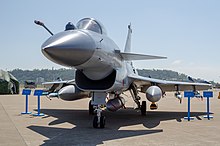
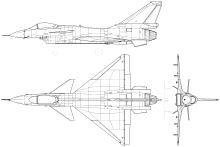
Data from
General characteristics
- Crew: 1
- Length: 16.9 m (55 ft 5 in)
- Wingspan: 9.8 m (32 ft 2 in)
- Height: 5.7 m (18 ft 8 in)
- Wing area: 37 m (400 sq ft)
- Empty weight: 9,750 kg (21,495 lb)
- Gross weight: 14,000 kg (30,865 lb)
- Max takeoff weight: 19,227 kg (42,388 lb)
- Fuel capacity: 4950 L (3860 Kg) internal. 4000 L (3120 Kg) external with 3 drop tanks (2x1600L + 1x800L)
- Powerplant: 1 × WS-10B afterburning turbofan engines, 89.17 kN (20,050 lbf) thrust , 135 kN - 144 kN with afterburner
Performance
- Maximum speed: Mach 2.2
- Stall speed: 200 km/h (120 mph, 110 kn)
- Range: 1,850 km (1,150 mi, 1,000 nmi)
- Combat range: 550 km (340 mi, 300 nmi)
- Ferry range: 4,600 km (2,900 mi, 2,500 nmi)
- Service ceiling: 18,000 m (59,000 ft)
- Rate of climb: 300 m/s (59,000 ft/min)
- Wing loading: 381 kg/m (78 lb/sq ft)
- Thrust/weight: 1.04
Armament
- Guns: 1× Gryazev-Shipunov GSh-23
- Hardpoints: 11 in total (6× under-wing, 2× under-intake and 3× under-fuselage) with a capacity of 5600 kg of external fuel and ordnance
- Rockets: 90 mm unguided rocket pods
- Missiles:
- Bombs:
Laser-guided bombs: (LS-500J, LT-2)
Glide bombs: (LS-6, GB3, GB2A, GB3A, GB250)
Satellite-guided bombs: (FT-1)
Unguided bombs: 250 kg, 500 kg
- Others:
- Up to 3 external fuel drop-tanks (1× under-fuselage, 2× under-wing) for extended range and loitering time
Avionics
- Radar
- AESA radar (J-10C)
- Type 1473H pulse-doppler fire-control radar (J-10A)
- Externally mounted avionics pods:
- K/JDC01A targeting pod (on J-10A)
- Type Hongguang-I infra-red search and track pod (on J-10A)
- CM-802AKG targeting pod for KD-88 and YJ-91 (on J-10C)
- KG600 electronic countermeasure pod
- Blue Sky navigation/attack pod
See also
Related development
- Chengdu J-9
- Shenyang J-13
- CAC/PAC JF-17 Thunder
- List of fighter aircraft
- List of aircraft produced by China
Aircraft of comparable role, configuration, and era
- AIDC F-CK-1 Ching-kuo
- Boeing F/A-18E/F Super Hornet
- Dassault Rafale
- Eurofighter Typhoon
- General Dynamics F-16 Fighting Falcon
- Mikoyan MiG-29 / MiG-35
- Mitsubishi F-2
- Saab JAS 39 Gripen
References
Citations
- The International Institute for Strategic Studies 2024.
- "Chengdu J-10 (Jian-10, Fighter aircraft-10 / F-10)". globalsecurity.org. Archived from the original on 18 October 2007. Retrieved 23 October 2007.
- ^ Bronk 2020, p. 39.
- ^ Wang Jieqing. "J-10 Fighter Test Flight Process Secret Revealed". Southern Weekend. Archived from the original on 21 March 2007. Retrieved 4 January 2007.
- "Chinese Equipment Guide" (PDF). US Navy Intelligence Office.
- ^ Jennings, Gareth (11 March 2022). "Pakistan receives first J-10 fighters from China". Janes. Retrieved 23 June 2022.
- ^ Research, Development, and Acquisition, page 2
- ^ Research, Development, and Acquisition, page 3
- ^ Wood & Stewart 2019, p. 61.
- ^ Wood & Stewart 2019, p. 62.
- China’s Aeroengine Industry, page 26
- ^ Research, Development, and Acquisition, page 4
- ^ Wood & Stewart 2019, p. 41.
- Wood & Stewart 2019, p. 63.
- ^ Rupprecht, Andreas, 2013. Dragon's Wings. Birmingham: Ian Allan Publishing Ltd.
- ^ "SibNIA remains center of Russian innovation". 2007. Archived from the original on 1 February 2014. Retrieved 25 June 2022.
- Waldron, Greg (21 May 2021). "China's J-10 comes of age with indigenous engine". flightglobal.
- Yeo, Mike (11 May 2021). "China fields J-10 jets powered by homemade engine". Defense News. Retrieved 11 May 2021.
- "Pakistan Purchases Chinese Jets Based on Scrapped Israeli Lavi Fighter". Haaretz. Retrieved 5 January 2022.
- Hewson, Robert. "Chinese J-10 'benefited from the Lavi project'". Archived 26 May 2008 at the Wayback Machine Jane's, 19 May 2008.
- "Exclusive Interview with J-10 General Designer Song Wencong". 2007. Archived from the original on 24 January 2009. Retrieved 6 January 2007.
- "少将驳斥"战机抄袭论":歼-10源自于歼-9". 2012. Archived from the original on 27 January 2013.
- "中国第四代先进战机机头及座舱亮相珠海航展(图)-吊舱,头盔瞄准具,航电系统,凤凰网,凤凰新媒体-黄岩新闻网". Archived from the original on 21 November 2015. Retrieved 4 February 2015.
- sina UI Team. "这个是歼10战机飞行员头盔瞄准具吗?". Archived from the original on 22 November 2015. Retrieved 4 February 2015.
- ^ Wood, Yang & Cliff 2020, p. 45.
- Wood, Yang & Cliff 2020, p. 24.
- ^ Johnson, Reuben F. (22 November 2019). "Dubai Airshow 2019: China's Chengdu promotes J-10C export variant". Janes. Retrieved 20 September 2020.
- "AL-31FN" (in Russian). Salyut. Archived from the original on 8 October 2011. Retrieved 12 January 2013.
- ^ Ju, Juan (5 March 2020). "Images suggest China has begun fitting indigenous WS10 engine into J-10C fighters". Janes. Retrieved 20 September 2020.
- "FSUE "Gas-Turbine Engineering RPC "Salut" has successfully completed the first phase of engine longevity and performance bench tests in view of future deliveries of a new version of AL-31FN Series 3". Salut. 24 December 2013. Archived from the original on 9 January 2014. Retrieved 24 December 2013.
- Wood & Stewart 2019, p. 32.
- Giovanzanti, Alessandra (23 November 2021). "PLAAF 25th Air Brigade now operates J-10C multirole fighters". Janes. Retrieved 6 January 2022.
- ^ Rupprecht, Andreas (2018). Modern Chinese Warplane: Chinese Air Force - Aircraft and Units. Harpia Publishing. p. 118. ISBN 978-09973092-5-6.
- ^ "Sinodefence.com: J-10 Multirole Fighter Aircraft". Archived from the original on 29 March 2007. Retrieved 9 April 2007.
- ZX, ed. (16 April 2018). "China's fighter jet J-10C begins combat duty". Xinhuanet. Archived from the original on 29 April 2018. Retrieved 28 April 2018.
- Abrams, Abraham (2024). J-20 Mighty Dragon: Asia's First Stealth Fighter in the Era of China's Military Rise. Warwick: Helion. p. 58.
- "Pakistan will stand by China against US 'siege', says Rashid". Daily Times (Pakistan). 23 February 2006. Archived from the original on 3 February 2008. Retrieved 8 September 2013.
- Ansari, Usman (3 August 2011). "China Officially Offers Pakistan J-10 Variant". Defense News. Archived from the original on 31 January 2012. Retrieved 8 September 2013.
- "J-10B fighter planes, 6 marines for Pakistan as Cino-Pak talks underway and lead to pakistan acquiring 100 j-10 and f16 super hornets". The News Tribe. 22 March 2012. Archived from the original on 14 September 2013. Retrieved 10 September 2013.
- Chowdhury, Srinjoy (6 September 2020). "Pakistan reaches out to China for more fighter jets and missiles". Times Now. Retrieved 4 February 2021.
- Kumar, Ankit (29 December 2021). "Pakistan confirms raising squadron of Chinese J-10C in response to India's Rafale jets". India Today. Retrieved 29 December 2021.
- "Pakistan acquires squadron of elite J-10C fighter: reports". Pakistan Today. 30 December 2021. Retrieved 6 January 2022.
- "Pakistan receives first batch of China's J-10CE fighter jets - SAMAA". Samaaenglish.tv. Retrieved 14 March 2022.
- "Multi-role J-10C fighter jets inducted into PAF fleet". 11 March 2022.
- "Six China-made J-10C jets inducted into PAF". 12 March 2022.
- "Explained: Which weapons were used, how exactly did Pakistan carry out airstrikes in Iran?". 18 January 2024.
- "Pakistan approves purchase of Lockheed Martin F-16s and Chengdu J-10 fighters-13 April 2006-Washington DC-Flight International". Flightglobal.com. 13 April 2006. Archived from the original on 13 December 2009.
- Lei, Zhao (18 February 2016). "PLA's fighter jets go up for sale". China Daily. Archived from the original on 19 February 2016. Retrieved 19 February 2016.
- ^ Parken, Oliver (29 March 2023). "The J-10 Changed China's Fighter Game 25 Years Ago". The Drive.
- Kopp, Carlo (10 July 2007). "J-10S Dual Seat Variant". Air Power Australia. p. 1. Archived from the original on 4 August 2018. Retrieved 4 August 2018.
- Ivanov, Henry (9 January 2006), China working on "Super-10" advanced fighter, Janes Defence World, archived from the original on 11 January 2006
- ^ Weening, Alexander; Hardy, James (9 October 2014). "New pictures of J-10B revealed". IHS Jane's 360. Archived from the original on 29 April 2015. Retrieved 6 August 2015.
- Fisher, Richard D. Jr. (12 January 2015). "Images suggest J-10Bs close to entering Chinese service". janes.com. Archived from the original on 30 April 2015. Retrieved 25 May 2015.
- "New J-10 Variant sighted". Janes Defence News. 23 March 2009. Archived from the original on 26 March 2009. Retrieved 23 May 2011.
- WALDRON, GREG (6 November 2018). "J-10B TVC wows Zhuhai crowds with surprise performance". flightglobal. Archived from the original on 7 November 2018. Retrieved 7 November 2018.
- Giovanzanti, Alessandra. "Images emerge of J-10C fighters for Pakistan". Janes. Retrieved 19 February 2022.
- Chuanren, Chen. "New Chinese Weapons Seen on J-10C Fighter". Aviation International News. Archived from the original on 10 January 2019. Retrieved 1 January 2019.
- "New BVRAAM may have entered PLAAF service". janes.com. Archived from the original on 17 May 2018. Retrieved 1 January 2019.
- "How good is China's J-10C fighter? We ask Justin Bronk from the RUSI think-tank". Hush-Kit. 26 February 2019.
- Bronk 2020, p. 41.
- The International Institute for Strategic Studies 2024, p. 260.
- The International Institute for Strategic Studies 2024, p. 304.
- "China's J-10C Fighter Jet Is A Killer In the Sky". 20 August 2024. Retrieved 15 December 2024.
- Guo, Kai (14 November 2016). "Black box of plane that crashed and killed female fighter pilot found". People's Daily. Archived from the original on 15 November 2016. Retrieved 16 January 2022.
- "Chinese fighter jet taken down by bird | Taiwan News | Oct. 5, 2020 17:17". taiwannews.com.tw. 5 October 2020. Retrieved 23 October 2024.
- 褚文 (19 November 2019). "【對外軍售】中國三代機進軍國際市場? 殲-10C首亮相杜拜航展" (in Traditional Chinese). 香港01. Retrieved 23 January 2022.
- ^ "J-10 (Jian 10) – Vigorous Dragon Multi-Role Tactical Fighter, China". SPG Media Limited. 10 February 2008. Archived from the original on 13 July 2007.
- "Aerospaceweb.org | Aircraft Museum - J-10 / F-10". www.aerospaceweb.org.
- "China's J-15 naval jet appears with indigenous WS-10 engines". Janes.com. Retrieved 14 May 2024.
- Honrada, Gabriel (27 November 2022). "China fighters ditching Russia for homegrown engines". Asia Times. Retrieved 14 May 2024.
- 空军发布 (17 April 2018). "空军新型战机歼-10C战斗值班,深圳卫视说了啥?" (in Simplified Chinese). Weibo. Retrieved 23 November 2022.
- ^ "网页已删除". Archived from the original on 18 April 2019. Retrieved 18 April 2019.
- "韩国防长参观中国空军飞行试验基地登上歼10_新浪军事_新浪网".
- Rupprecht, Andreas (29 October 2018). Modern Chinese Warplanes - Chinese Air Force. Harpia Publishing. p. 46. ISBN 978-0-9973092-6-3.
- Chuanren, Chen. "New Chinese Weapons Seen on J-10C Fighter". Aviation International News. Archived from the original on 10 January 2019. Retrieved 1 January 2019.
- ^ Rupprecht, Andreas (2018). Modern Chinese Warplane: Chinese Air Force - Aircraft and Units. Harpia Publishing. p. 121. ISBN 978-09973092-6-3.
Bibliography
- Bronk, Justin (October 2020). Russian and Chinese Combat Air Trends (PDF) (Report). Whitehall Report. Vol. 3–20. Royal United Services Institute for Defence and Security Studies. Retrieved 3 September 2024.
- Erickson, Andrew; Lu, Hanlu; Bryan, Kathryn; Septembre, Samuel (2014). Research, Development, and Acquisition in China's Aviation Industry: The J-10 Fighter and Pterodactyl UAV. Annual Review of China’s Defense Technology and Industrial Base. 7. University of California Institute on Global Conflict and Cooperation.
- The International Institute for Strategic Studies (2024). The Military Balance 2024. Routledge. ISBN 978-1-032-78004-7.
- Wood, Peter; Stewart, Robert (26 September 2019). China's Aviation Industry: Lumbering Forward (PDF). United States Air Force Air University China Aerospace Studies Institute. ISBN 9781082740404. Archived from the original (PDF) on 28 June 2021. Retrieved 20 September 2020.
- Wood, Peter; Wahlstrom, Alden; Cliff, Roger (March 2020). China's Aeroengine Industry (PDF). United States Air Force Air University China Aerospace Studies Institute. ISBN 9798637786664. Archived from the original (PDF) on 27 March 2021. Retrieved 22 November 2020.
- Wood, Peter; Yang, David; Cliff, Roger (November 2020). Air-to-Air Missiles: Capabilities and Development in China (PDF). Montgomery, Alabama: China Aerospace Studies Institute. ISBN 9798574996270.
External links
- AirForceWorld.com J-10 article
- J-10B fighter jet article
- GlobalSecurity.org article on the J-10
- SinoDefence.com J-10 factsheet and pictures
- Chinese Military Aviation at Stormpages.com
- Milavia.com J-10 article and pictures (includes J-10 specifications from Air Forces Monthly magazine)
- SinoDefence.com article on J-10B
- Jane's Defence article on J-10B
| AVIC aircraft and aero engines | |
|---|---|
| Fighter and attack aircraft | |
| Bombers | |
| Trainers | |
| Transport aircraft | |
| Commercial aircraft | |
| Civilian airship | AS700
|
| Helicopters |
|
| Ultralight aircraft | |
| UAVs and UCAVs | |
| Engines | |
| Missiles | |
| Miscellaneous | |
| Chinese military aircraft | |||||||||
|---|---|---|---|---|---|---|---|---|---|
| Fighters |
| ||||||||
| Bombers | |||||||||
| AEW&C and EW | |||||||||
| Tankers | |||||||||
| Reconnaissance | |||||||||
| Transport |
| ||||||||
| Trainers | |||||||||
| Helicopters |
| ||||||||
| UAVs and UCAVs |
| ||||||||
| |||||||||
| Chinese People's Liberation Army fighter designations | |||||
|---|---|---|---|---|---|
| Jiān "J" (Fighter) | |||||
| Export |
| ||||
| Related designations |
| ||||
| Unknown/not assigned • Unconfirmed/speculation See also: J-XX | |||||
| Active Chinese military aircraft | |||||||
|---|---|---|---|---|---|---|---|
| Fighters |
| ||||||
| Bombers | |||||||
| AEW and AEW&C | |||||||
| Tankers | |||||||
| Reconnaissance | |||||||
| Transport |
| ||||||
| Trainers | |||||||
| Helicopters |
| ||||||
| UAVs and UCAVs |
| ||||||
| |||||||